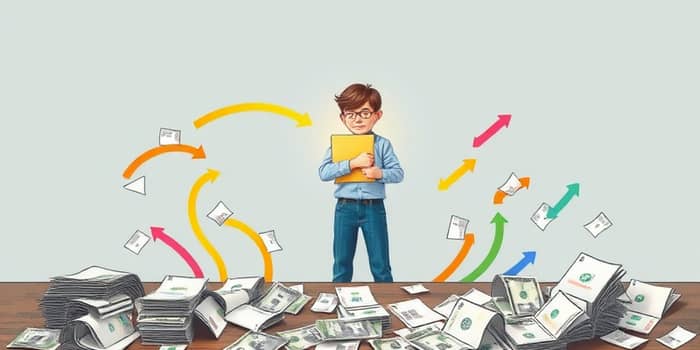
By 2025, reducing debt is the number one financial priority for Americans, with 42% citing it as their top goal. Rising credit card APRs averaging above 20% are squeezing budgets and making repayment feel like an uphill battle.
Debt consolidation can transform this challenge into an opportunity by bundling multiple obligations into a single, manageable payment.
Debt consolidation means combining multiple debts into a single loan or payment. The core goal is to simplify finances by reducing the number of payments and credit relationships you manage each month.
When executed properly, consolidation can offer a clear path towards financial stability and help borrowers avoid the trap of juggling multiple high-rate accounts.
There are three primary methods consumers use to consolidate outstanding balances:
Debt consolidation loan is a personal loan taken to pay off existing debts in full. Applicants typically seek rates between 10% and 15%, well below the average credit card APR.
Balance transfer credit card involves moving high-interest balances to a new card with a 0% introductory APR for 12–21 months, though it often carries a transfer fee of 3%–5% of the balance.
Home equity loan or line of credit leverages the equity in your home to secure funds at lower rates. While this can mean substantial savings, the risk of foreclosure makes it a decision to weigh carefully.
Choosing the right consolidation strategy can yield several advantages:
First, single monthly payment simplifies finances by funneling multiple obligations into one bill. This reduces paperwork, minimizes the chance of accidental missed due dates, and can help maintain a better payment history.
Second, borrowers with credit scores above 680 often qualify for lower interest rates than credit cards, freeing up cash flow. Third, if you commit to a structured repayment, consolidation can accelerate your path to debt freedom by focusing payments toward one principal balance.
With fewer accounts drawing down your available credit, you may also see an improvement in your credit utilization ratio, which can further boost your credit score over time.
Beyond financial metrics, consolidation empowers borrowers with a clear budget roadmap. When you eliminate the need to track various due dates and balance minimums, you can allocate any extra funds toward accelerated payoff, further trimming interest costs.
Many consumers report a significant drop in anxiety once they have peace of mind over finances each month, knowing exactly what is due.
No financial product is without its downsides. Potential obstacles include:
• Fees and costs such as loan origination fees (1%–8% of loan amount) or balance transfer fees (3%–5%).
• Promotional APRs may expire, causing rates to revert to high levels if you haven’t paid off the balance in time.
• Extending repayment terms can lower your monthly payment but increase the total interest paid over the life of the loan.
• Using home equity exposes your residence to risk of foreclosure if you miss payments.
• Each new credit application triggers a hard inquiry, which can temporarily lower your credit score by a few points.
Additionally, switching debt from unsecured to secured (in the case of home equity) alters your risk profile dramatically. Evaluate whether the potential savings outweigh the stakes of your collateral.
Not every borrower will benefit equally from consolidation. Ideal candidates often share these traits:
• Total unsecured debt between $10,000 and $50,000.
• Credit score above 680 and a debt-to-income ratio below 45%.
• Steady employment history and reliable income to support new loan payments.
If your balances are small, your rates are already low, or you haven’t addressed the underlying spending habits that caused the debt, consolidation may not deliver meaningful relief.
Follow these steps to consolidate responsibly:
1. Compile a comprehensive list of all unsecured debts, including balances and interest rates.
2. Review your credit report for errors and work to improve your score if possible before applying.
3. Shop around for the lowest rates, comparing offers from banks, credit unions, and online lenders.
4. Apply for the consolidation product that best matches your financial profile and goals.
5. Use the new loan or card proceeds to pay off existing balances in full, then focus on the single repayment.
6. Resist the urge to accrue new debt; avoid accumulating new debt by sticking to a strict budget during the repayment period.
7. Set up auto-pay to ensure consistent on-time payment and avoid late fees. Monitor your progress with monthly statements and adjust your budget to channel any extra money toward debt acceleration.
8. Keep closed accounts on your credit report open if possible, as their age contributes positively to your credit history length.
Debt management plans, offered by nonprofit credit counselors, can negotiate lower interest and combine payments without requiring new credit. Debt settlement involves negotiating with creditors for a reduced payoff; this can harm your credit score. Bankruptcy should be a last resort for those facing unmanageable obligations, as it carries long-lasting credit consequences.
Industry professionals caution borrowers to always read the fine print on rates, fees, and repayment terms. Interest rates are expected to remain high throughout 2025, so acting swiftly can secure the most favorable terms. Importantly, view debt consolidation as a tool—not a cure-all; address spending behaviors long term through a realistic budget and financial plan.
Before diving in, consult a reputable financial advisor or credit counselor to ensure consolidation aligns with your unique situation.
Debt consolidation can be a powerful strategy to take control of your finances, reduce stress, and pay off balances more efficiently. By understanding the options, evaluating the costs and benefits, and committing to better spending habits, you can transform multiple obligations into a single path toward financial freedom.
Ultimately, consolidation is most effective when combined with a proactive approach to budgeting, emergency savings creation, and continuous financial education. Pair your consolidation plan with these habits to ensure that you don’t slip back into the cycle of debt. Make an informed decision today, and pave the way for a more secure tomorrow.
References













